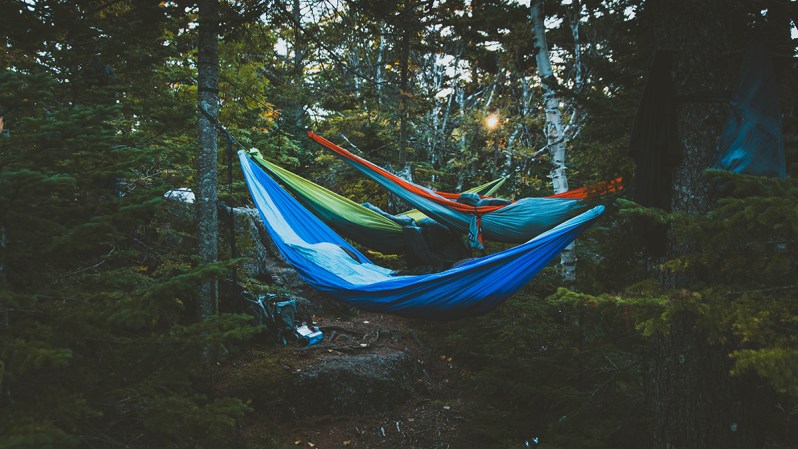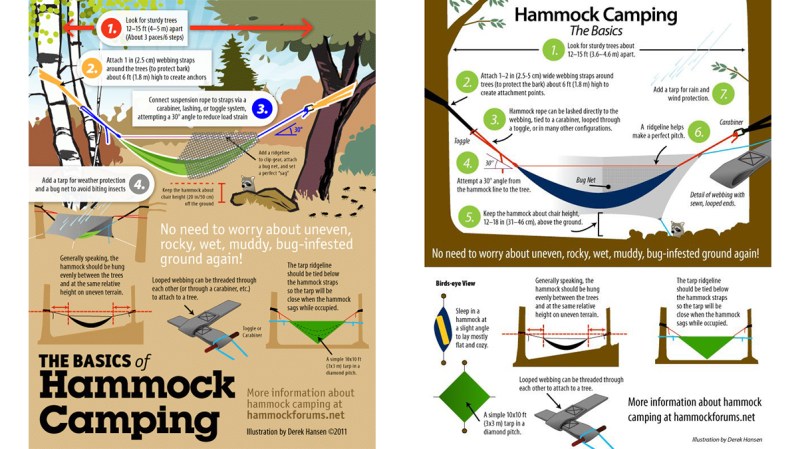When we think of hammocks, many see it as a leisure activity. Maybe you dream of setting up shop nestled between two trees at a shady park, a hammock chair from the rafters of your front porch, or even a hammock tent for your extended outdoor adventure.
For many Native cultures in Central and South America, these beds served a preeminent purpose. By having a bed that was raised off the ground, they could then protect themselves from snakes, spiders, ants, or any other danger lurking below.
So, there’s more than just leisure to hammocks; though if that’s what you fancy, that’s cool too. But regardless of your motivation, knowing how to hang a hammock is your first step towards spending an afternoon cradled in deep thought, or protected and comfortable during the unexpected nights on your backpacking trip.
Flagstaff, Arizona-based Hammock Enthusiast, Derek Hanson, has written the ultimate guide, filled with illustrations, easy tips, and essential techniques on how to hang a hammock.
Preparation
We’ve come a long way from the early hammocks woven from the bark of the Hamack Tree (hamacas) found among Native Central and South America tribes. These suspended beds, now referred to simply as hammocks, can be made from a variety of materials — nylon, rope, drop cloths — anything that’s durable, flexible, and can hold some weight. They can be crafted at home or purchased for assembly.

(For DIY hammock creatives, check out these ideas on Bob Vila’s website.)
Hammocks can be hung from trees, anchored posts, or poles, stands, and even hung from wall and ceiling studs. There are also different methods you can choose from when learning how to hang a hammock. We recommend using Atlas’ hammock suspension straps. These straps are lightweight and ideal for camping or multiple uses, are less damaging to trees, and can be adjusted easier than other materials such as chain or rope.
You could also opt to use hanging hardware. In that case you’ll need the following: two wall anchors, two 1.5-foot long pieces of chain, and two large S-hooks. Adjusting the hammock tension is also easy with this system, and it’s also a popular method for hanging a chair style hammock or a hammock indoors. Hansen gives a quick and easy tutorial on this method at the end of the article.
How to hang a hammock
For hanging between two trees, Hansen’s techniques are digestible and flexible. He’s become an idol in the hammock community with his book, The Ultimate Hang, and his invention of The Hammock Hang Calculator.
The calculator makes hammock hanging easier than hanging a painting in your home, as it tells you where exactly to set your suspension points based on distance between anchors in order to achieve the perfect hang, every time. Yes, it’s that easy.
(Note: The tighter you pull your hammock, the greater the forces will be on the suspension and anchor points. If you’re not using the hang calculator, shoot for an approximate 30 degree angle.)

Hansen says he loves “clear, informative illustrations” and that’s what he strives for in his work. Growing up near the foothills of the Rocky Mountains, Hansen gained a love for the outdoors thanks to active Scouting parents and enjoyed his first hammock hang at age 14 at a Boy Scout high-adventure base.
Hammock Recommendations
For the guy who wants to have a hammock in his arsenal of day trips to the park or collecting deep thoughts in his own backyard, this durable DoubleNest Hammock from Eagles Nest Outfitters is an ideal selection for multiple uses as it packs away with ease.
For hammock camping, this lightweight and durable suspension bed from Sea to Summit is perfect for backpacking trips and minimalists. It’s mesh material is excellent for acclimating to warmer climates and it rolls up easy into an integrated stuff sack.
If you’re looking to become a hammock camping expert, you can buy Hansen’s detailed book filled with over 200 illustrations here for just under $15. Learn everything you need to know on hammock
Searching for how to hang a hammock inside of your house? Hansen put together a short video detailing the step-by-step process:
Good luck and get hanging!


